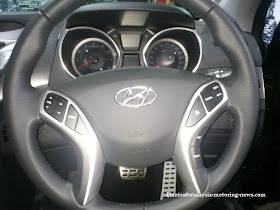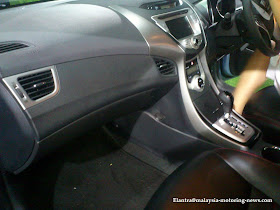Hyundai new Elantra is the successor to the outgoing Avante compact sedan for Malaysian market. This time around Hyundai-Sime Darby Motors has made a commanding decision to assemble the car in Malaysia to make it more competitively-priced against other establishment in compact sedan market, namely Kia Forte, Honda City and Toyota Vios, as well as the C Segment stalwart like Honda Civic and Toyota Corolla Altis.
As per other CKD-ed Hyundai, the new Elantra wears the Inokom badge on the outside, while the badging on the interior has retained the italic "H". For Malaysian market, 4 variants are up for offer namely 1.6L in Standard trim (6 speed manual or 6 speed automatic) and High Spec (automatic only) and the 1.8L in High Spec (Auto only). Price for each model are RM86,888, RM91,888, RM96,888 and RM111,888 respectively.
The new Elantra is skinned with the latest evolution of Hyundai's fluidic sculpture design concept. Fluidic Sculpture concept emphasize the fusion of the wind and rigid surface to create the illusion of dynamism. This can be seen in the strong flowing lines present on the body surface. The front end of the new Elantra is dominated by the new Hyundai corporate grille design, the hexagonal outlay flanked by the heavily swept back headlamp. Overall the design presence is less intense than the sharp flamboyant lines on the Sonata, and the fussiness of the Tuscon. The new body styling is less draggy too, with drag coefficient stands at 0.28, among the lowest among the mass-produced 4 door sedan compact car.
As can be seen above, the snout of the Elantra is not as attention-demanding as the Sonata. The soft radii lends a more cohesive and pleasing look, not to mention more relaxing to the eye too. The chromed slats you see on the car here is exclusive to the 1.8L version, with the 1.6L make do with blackened slats.
The white 1.8L here wears non-standard skirting and alloy wheel. The standard alloy wheels are 16" for the 1.6L wrapped with 205/55 R16, while the 1.8L is shod with 215/45 R17 tyres.
The side profile of the new Elantra is nice wedge shape, with flowing theme continues with the strong belt line character crease that melt into the wrap-around rear tail light. The rear door trailing edge window line kick upwards, ending with sharp delta panel. Note that the extra delta is no longer part of the door, instead is a stylistic element added to the C-pillar. More and more details (+gallery) after the jump.
Interior
The interior of the new Elantra is an epitome of Hyundai's new interior design theme. The dashboard retain the similar flowing lines from the exterior cues, with the narrowing outlines for the audio control that tapered towards the centre of the console before diverging again towards the gear console. The centre console is flanks by the silver garnish that lift the meter ambiance, in conjunction with the chrome-surround meter binnacles, sparked some more by the brightwork in the gear console and steering wheel.
It is worth to note that the upper section of the dashboard is made of soft-padded material. So it is a soothing soft touch material here instead of pseudo soft looking texture. The rest of the interior, although adorned with hard plastic, they are at least pleasantly textured.
The space upfront is great for both the driver and front passenger. Driving position is spot-on, especially with tilt and telescopic adjustment available for 1.8L and 1.6L High Spec. The lower price variants gets the tilt adjustment only. The 1.8L also is equipped with powered driver seat.
Leather seats is standard for all model. The 1.6L Standard is upholstered with Grey leather seats, while the 1.6L High Spec and 1.8L gets black leather, with the 1.8L version adopting a more expensive Nappa leather. The rear legroom is excellent too with sufficient knee room even for 1.8m guy. Headroom however is a bit on the premium side, due to the sloping roofline. It is however perfectly acceptable. However, there is no rear aircond duct, but perhaps it is too much to ask for at this price category.
The interior of the new Elantra is highly specified too. Apart from the aforementioned leather, the 1.8L also gets the dual zone auto airconditioning (1.6L use manual system). Aux, USB and iPOD connectivity is standard across the board, while the 1.8L gains additional touch screen system incorporating GPS, DVD and reverse camera display. However, the display screen for the 1.6L could be better than the green-backed item, perhaps a more modern looking black backlight with white read-out will match the interior theme better. During the test drive, the touch screen item on the 1.8L is hard to see under strong sun light. Starter button is included too from 1.6L High Spec onwards. 1.8L version also get the sunroof.
Utility
The boot of the new Elantra can swallow 420L worth of luggage, which is on par with the class average. Kia Forte accommodates around the same amount, while Honda Civic, Toyota Corolla and Vios swallow a bit more. Honda City is in a different league at 506L, while the forthcoming Proton Preve will swallow 508L, a clear class leader.
 The front occupants also get twin cupholder within the centre console. From this picture, it is clear to see Hyundai attention to detail with the chrome trimmings surrounding the holder outlines, while the first of the cupholder is shaped deeper to allow multi-type of cup to be hold.
The front occupants also get twin cupholder within the centre console. From this picture, it is clear to see Hyundai attention to detail with the chrome trimmings surrounding the holder outlines, while the first of the cupholder is shaped deeper to allow multi-type of cup to be hold.
Drivetrain
Design Detail
There are two engine options for the Hyundai Elantra. The first one is the Gamma 1.6L MPI D-CVVT engine which adopts an all-aluminium construction and equipped with Dual Continously Variable Valve Timing systems. This 1,591 cc engine kicks out 130PS@6300rpm and 157Nm@4850rpm. The output is clearly on the high-side for the modern NA 1.6L lump where the nearest challenger is running out of talent at 125bhp. The 1.8L version meanwhile is the Nu MPI D-CVVT, punching out 150PS@6500rpm and 178Nm@4700rpm. Clearly, the engines are tuned to lead the pack, at least of paper power output.
Two transmission option are available in Malaysia. The sure-minority is the 6 speed manual transmission. This model is not available during the preview test drive last week. The other one is 6 speed automatic transmission. Seems that the Korean is pushing to equipped their mainstream model to have a 6 ratios, while certain Japanese model is trundling around with 4 speeder.
Design Detail
The new Elantra is rich with interesting design detail. The side mirror is a sculpture, with its base heavily sculpted to blend nicely with the delta cover. Look at the side mirror surfacing. The frontal fascia is basically joint by the lower surface at different angle which wrapped around towards the top part.
The headlight inner graphic that include the chromed winged element. It gives the impression of a mean looking eye.
Notice how the trunk lid parting line with the side outer panel structure is continued downwards by the bumper shutline? The wheelarch flaring arches are cascaded to the bumper lines that runs offset from rear light housing surfaces. Amazing....
The mating point for fender penal, front door outer panel, hood, A-pillar and delta cover. Notice how the lines from the A-pillar run uninterrupted to the hood?
This was what mentioned earlier. The rear door edge kicked upwards. The delta panel is just a styling extension instead of rear door aperture. The door aperture is as seen below.
Dimension and Chassis
Hyundai Elantra is 4,530mm long, 1,775mm wide and 1,445mm tall. The car rides on 2,700mm wheelbase. The car rides on McPherson strut front suspension and torsion beam setup for the rear. Braking power is povided by 15" disc at the front and 14" item at the back. The steering is of MDPS type, Motor Drive Power Steering which utilize electric current and motor to enable varying degree of assistance according to the vehicle speed, engine load, steering angle and this help to save fuel.
Ultra high strength steel is used for safety-critical section including the crash box and knee protection area. The side member of the B-pillar is of hot stamping product to give superior resistance to deformation in the likelihood of side impact. ESP and VSC are the added safety measures for 1.6L High Spec and 1.8L. Dual SRS and ABS meanwhile are standard across the range.
Driving Impression
MMN sampled both the 1.6L High Spec and 1.8L versions during the launching event last week. The first impression in the cabin for both version is the seats are supremely comfortable with good driving position easily found. The view outwards the front is excellent, as are the side views. Rear view however is what is expected of a high-trunk sedan.
The 1.6L is sufficiently powerful for some spirited burst of acceleration. It certainly feels faster than the quoted 11.6s century sprint. The steering is nicely weighted, with none of the extreme lightness found on many Japanese model. The suspension soaks up the road bump nicely. The engine and road noise are well insulated from the cabin.
The 1.8L instantly feels more powerful, with noticeably more urgent delivery of speed upon depressing the gas pedal. However, the engine roar is more audible, so are the tyre noise. I was told that the Continental MC5 for the 1.8L version offers greater grip, but at the expense of road comfort.
For both engine variant, the 6 speed automatic gearbox is creamy smooth. MMN personally prefer the conventional torque converter (and of course DSG) over the CVT on any given day. For the Elantra, manual overides is available with the +/- option within the gated gear console. No paddle shifter though.
The test drive is too short to conclude anything on the power and speed delivery on the highway speed, neither sufficient to test the handling of the car too within the strict constraint of the test drive route. Perhaps a longer test drive will help to assess the car better against the class establishment. But the initial signs are great and competitive.
Conclusion
It is unfair to compare the price of the Inokom Elantra to the ageing Kia Forte. Admittedly, RM91,888 for the Standard Spec is a fair bit more that the Forte 1.6. However, PLEASE note that Forte sits on the same platform as the Hyundai Avante, which essentially a generation older now. The new Forte (click HERE) has been spied since last year and it is as svelte and hefty looking as the new Elantra. No surprise as they will again share their platform. No guarantee if Naza can maintain the same level of pricing for the new Forte.
There is no point to compare the Elantra to the Honda City and Toyota Vios as those two are overpriced Japanese offerings that offer little metal for your RM. The real test will be against the forthcoming Proton Preve, which will be as big as the Elantra, packed a turbo-punched, and most important of all will topped at RM75,000. Admitedly Hyundai Elantra is more stylish and modern looking with distinctive interior to match. Amcam Preve? Ada berani ka?
If you are interested to own the new stylish Elantra, you can contact Hyundai Old Klang Road Sales Consultant Mr. Benjamin Ang at 012-5272562.
Small gallery of Hyundai Elantra can be found below.
Gallery









































No comments:
Post a Comment
Share you thought?